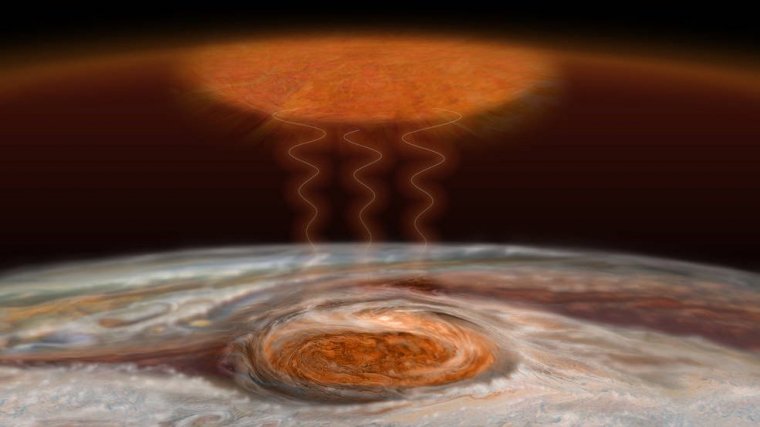| News / Space News |
Jupiter’s Great Red Spot Likely a Massive Heat Source
NASA | AUGUST 4, 2016
New NASA-funded research suggests that Jupiter’s Great Red Spot may be the mysterious heat source behind Jupiter’s surprisingly high upper atmospheric temperatures.

Artist’s concept of the heating mechanism from Jupiter’s Great Red Spot. ![]()
Here on Earth, sunlight heats the atmosphere at altitudes well above the surface. Scientists have been stumped as to why temperatures in Jupiter’s upper atmosphere are comparable to those found at Earth, yet Jupiter is more than five times the distance from the sun. They wanted to know: if the sun isn’t the heat source, then what is?
Researchers from Boston University’s Center for Space Physics set out to solve the mystery by mapping temperatures well above Jupiter’s cloud tops using observations from Earth. By observing non-visible infrared light hundreds of miles above the gas giant, scientists found temperatures to be much higher in certain latitudes and longitudes in Jupiter’s southern hemisphere, where the spot is located.
The study concludes that the storm in the Great Red Spot produces two kinds of turbulent energy waves that collide and heat the upper atmosphere. Gravity waves are much like how a guitar string moves when plucked, while acoustic waves are compressions of the air (sound waves).
Heating in the upper atmosphere 500 miles (800 kilometers) above the Great Red Spot is thought to be caused by a combination of these two wave types “crashing,” like ocean waves on a beach.
This effect has been observed over the Andes Mountains here on Earth and may also be happening elsewhere in the outer solar system, though it has not been directly observed. Scientists believe this phenomenon also occurs on giant exoplanets orbiting other stars.
The Great Red Spot (GRS) has delighted and mystified since its discovery in the 17th Century. With its swirl of reddish hues, it’s 2-3 times as wide as Earth and is seen by many as a “perpetual hurricane,” with winds peaking at about 400 miles an hour.
YOU MAY ALSO LIKE




